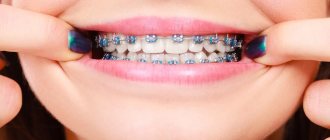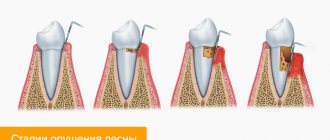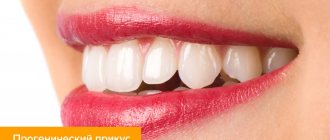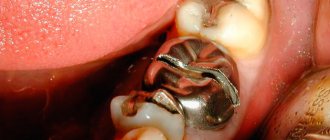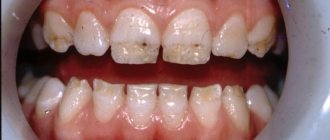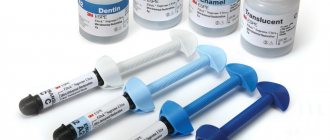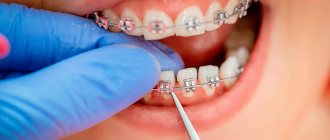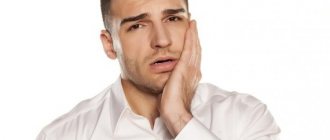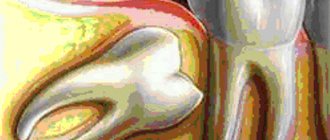Dentists say that it is better to carry out prosthetics almost immediately after tooth extraction. But how often does this happen - a tooth is removed, but no replacement is provided. There can be many reasons for this - lack of money, lack of awareness about prosthetic options and the consequences of an incomplete series. But as a result of such a delay, the teeth begin to “live their own life.”
Not in the literal sense, of course. Simply left without the support of a neighbor, the tooth moves, taking up free space. Teeth shift because the bone tissue at the site of the removed tooth becomes thinner and deformed. And now the neighboring tooth, under the influence of loads, tilts towards the free space. This process begins 2-3 months after tooth extraction.
Tooth displacement: reasons
The median straight line, which divides the face into two halves, should coincide with the interincisal median lines - that is, with those lines that can be conditionally drawn between the front teeth. All teeth should be symmetrically located relative to this line. If at least one tooth moves away from these lines, this is a malocclusion. In addition, there should be no increased spaces between the teeth; they should not overlap each other in the dentition.
The question of why teeth shift has long been of interest to orthodontists. In the 18th century, the French physician Pierre Fauchard, personal dentist of Louis XV, in his book “The Dentist-Surgeon, or Treatise on the Teeth” (1728), recommended tying abnormally growing teeth with silk threads to a strip of metal. At the end of the 19th century, Edward Engle proposed a classification, diagnostic methods and an apparatus for correcting occlusion, which was sold in American catalogs for about a hundred years - until the 1980s.
As doctors have established, heredity plays a large role in the occurrence of tooth displacement - if one or both parents had bite defects, then there is a high probability that they will appear in their children. In addition to heredity, the following reasons for displacement are distinguished:
- too late eruption of both milk and permanent teeth;
- disruption of the process of replacing baby teeth with permanent ones - for example, very early removal of a baby tooth;
- lack of space in the jaw arches (often leads to crowding of teeth);
- developmental anomalies of one or both jaws;
- abnormalities in tooth size;
- diseases of the temporomandibular joint;
- injuries to teeth and jaws.
In adults, tooth displacement can also occur due to injury or due to tooth loss or extraction. Neighboring teeth begin to shift towards the empty space, forming a malocclusion. This is one of the reasons why dentists, when teeth are lost, strongly recommend restoring them with prosthetics.
Treatment of incomplete dislocation
Dental treatment
If a dislocation occurs, it is necessary to seek dental care as quickly as possible; After local anesthesia, the dislocated tooth is repositioned, that is, it is placed in the correct position. The doctor places his fingers on the tooth, resting on the adjacent teeth and the alveolar process (alveolar part), and carefully puts it in place. Correctly performed reposition is indicated by the absence of contact of the dislocated tooth with its antagonist.
After placing the tooth in its normal position, it is immobilized using splinting. The splint is also placed on adjacent healthy teeth; the dislocated tooth should not experience pressure. Splinting lasts for 5-6 weeks, during this period the condition of the pulp is monitored using EDI. If it dies, depulpation is performed.
After depulping and cleaning the root canals, they are filled with calcium hydroxide to prevent root resorption. If, upon further observation within a year, resorption is not detected, the canals are filled with permanent material. Permanent teeth with unformed roots are filled with calcium hydroxide, periodically replacing the drug until the root tip is closed.
A gentle diet is prescribed, which excludes the intake of solid food: food should be soft, liquid or semi-liquid.
Drug treatment
When a tooth is dislocated, use:
- To relieve pain and relieve inflammation - non-steroidal anti-inflammatory drugs (ketorolac, ibuprofen, nimesulide, dexketoprofen).
- To prevent the addition of a bacterial infection, use antibacterial drugs (prescribed by a doctor).
- To relieve inflammation and swelling of the gums - rinse with infusions of sage, chamomile, eucalyptus.
- In case of traumatic swelling of the soft tissues of the face, use cold compresses; their temperature should not be lower than +4°C.
Physiotherapeutic treatment
In the post-traumatic period, treatment is carried out with physiotherapeutic methods that use electric and magnetic fields. Thanks to their action, the flow of immune bodies into inflamed tissues is enhanced, the level of inflammation is reduced, and healing processes are accelerated. They use: UHF therapy, magnetic therapy, magnetic laser therapy, exposure to microwaves.
Types of tooth displacement
While everything is quite clear about why teeth shift, many people are confused about the types of this problem. All bite defects are divided into 3 large groups.
- Violation of the position of the teeth: normally there are very narrow spaces between the teeth, and each tooth, except the last in the row, has 2 contact points with its neighbors. If there are enlarged spaces (tremas, diastemas) or teeth are crowded, then this is a defect that needs to be corrected - otherwise it will lead to problems with the gums and increased tooth wear,
- Violation of the development of dentition - they can be either narrowed or expanded.
- Abnormalities affecting the size or position of the jaws. These include:
a) cross bite - the jaws close in a cross direction horizontally, i.e. the teeth overlap;
b) mesial bite - the lower jaw protrudes forward;
c) distal bite - the upper jaw protrudes forward.
If any tooth has changed position as a result of injury or removal of an adjacent tooth, this is also a malocclusion that can be corrected by orthodontists.
Gastrointestinal disorders
A person chews food mainly with chewing teeth, which patients are often in no hurry to restore. As a result, food before entering the stomach is crushed less well and is not so abundantly moistened with saliva, which contains enzymes that trigger the process of breaking down nutrients in the oral cavity.
Due to poor chewing, not only gastritis with constant dull pain in the epigastrium can appear, but also cholelithiasis, stool disorders, colitis and other unpleasant diseases.
Correction of misaligned teeth
What to do if you see, for example, how the teeth on the lower jaw have shifted?
It seems to many that it is no longer possible to correct the situation in adulthood - the teeth will still return to the wrong position, and besides, correcting the bite is long, difficult and unaesthetic. Fortunately, orthodontists today are successfully correcting misalignments in adult patients. To do this, they use 2 orthodontic systems, which, using the pressure of a calculated force, carefully move the teeth to the correct position.
- Braces
A classic non-removable system that consists of a metal arch, braces - elements that are fixed to each tooth, and locks or ligatures that secure the arch in the braces. Today, these systems have become much more compact and comfortable, and we are no longer talking about long years of correction, since the average treatment period is only 1.5–2 years. Doctors have metal, ceramic, sapphire and combined systems at their disposal. There are also lingual braces - they are fixed on the lingual side of the teeth and are not visible when you smile. - Aligners
A removable system of aligners developed about 3 years ago that are worn on the teeth. For each patient, based on photographs and impressions of the jaws, an individual set of aligners is created, which the patient himself changes according to a schedule drawn up by the orthodontist. Unlike braces, aligners can be removed for 2 hours a day to eat and brush your teeth.
However, in any case, after removing the orthodontic system and completing the bite correction, a period of retention follows - when the patient wears retainers that prevent the teeth from returning to their previous position.
External changes
Due to missing teeth, facial muscles weaken, facial tissues begin to sag, which visually increases a person’s age and adds 7-10 years to it. The chin becomes sharper, the lower jaw protrudes above the upper jaw, the corners of the lips and the tip of the nose droop. This changes the overall facial expression, which constantly appears gloomy and dissatisfied to others. From a close distance, the absence of a tooth is clearly visible, even if it is not part of the smile.
Diagnostic measures
To identify the type of displacement, a photograph of a smile is assessed and the patient is prescribed an orthopantomogram. From the photo you can determine the presence of displacement and the degree of its severity. Using the second diagnostic method, the type of anomaly is determined.
If the clinic is not examined using OPTG, the problem will remain unrecognized and the patient will remain without treatment for the incorrect axial inclination of the frontal elements of the row.
The issue of correct diagnosis arises especially acutely in adult patients with increased abrasion of the cutting line of the upper jaw incisors and in children with teeth with traumatic chips.
The keys to optimally choosing treatment tactics are:
- length of the coronal part of the frontal units;
- posterior level of the occlusal plane;
- incisal platform;
- pupil lines.
If a discrepancy is detected between the line of the pupils and the incisal platform, the specialist performs a number of assessment actions:
- The relationship between the pupil line and the posterior and anterior levels of the occlusal surface is determined. If there is an obvious discrepancy, the cause of the displacement is most likely the pathological growth of the branches of the movable jaw.
- Determining the presence of a relationship between the posterior level of the occlusal plane and the pupil line. The coincidence indicates that the anomaly developed against the background of bad habits - thumb sucking, etc.
To thoroughly study the causes of the anomaly, the orthodontist must:
- Assess the morphometric parameters of the patient’s jaw apparatus and characterize his condition.
- Visually inspect the patient's jaw arches and assess the position of the units in relation to the midline of the face.
Expected Result
In the course of numerous studies, it was found that the anomaly discussed in the article often develops against the background of early tooth loss, as well as the process of eruption of the third molar.
Thanks to modern treatment methods, displacement in most cases can be completely eliminated or masked.
Let's consider the optimal methods for treating common clinical pictures when the center is displaced:
- Excessive eruption of the frontal and lateral units on one side of the jaw with an inclined position is a surgical technique aimed at repositioning the upper and mobile jaw and normalizing the relationship of the pupil line with the incisal plane.
Orthodontic treatment with a corrective appliance may also be required. - Increased abrasion, which has caused a change in the position of the anterior incisors - restoration measures of the incisors are recommended after preliminary correction of the position of the anterior units.
The reference point is the gingival level of the anterior elements. This way you can achieve the correct ratio between the width and length of the crown part.
